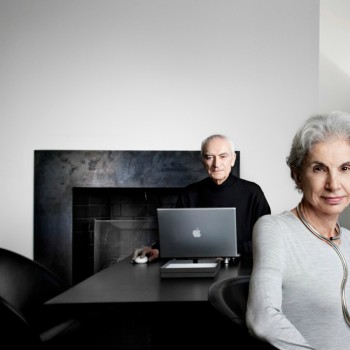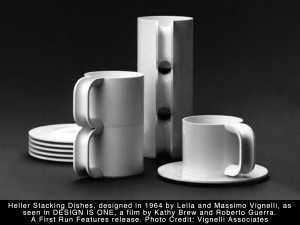Designers Massimo and Lella Vignelli moved in the 1960s from their native Italy to the United States, and they brought their Modernist aesthetics with them. They’d go on to become among the most influential designers of the late 20th Century, creating furniture and objects, developing iconic imagery for brands like American Airlines and Bloomingdales, and popularizing a then little-known European typeface called Helvetica.
“If you cannot find it, design it,” is the inspirational motto repeated throughout a new documentary about their career, “Design is One.” Massimo talks about what a designer does, why he doesn’t consider himself an artist, and how his work civilized Americans.

Brendan Francis Newnam: I want to start with a really basic question. What does a designer do?
Massimo Vignelli: A designer works hard to solve other people’s problems. Generally speaking, you know? And using visual languages to do that, basically.
A client comes with a problem, you listen, you try to interpret that, what his needs are — not his wants, they’re different! So, what I’ve done all my life, I started with a pencil, and then I start to design.
Brendan Francis Newnam: In the movie you make an interesting point about the difference between a designer and an artist.
Massimo Vignelli: Well, design is very different from art. Art doesn’t need a client, basically. While a designer without a client is out of business.
Brendan Francis Newnam: You are trying to meet someone else’s needs.
Massimo Vignelli: Sometimes the needs are even our own! Let’s say that we are doing an interior or a restaurant or whatever may be, and we need a chair, and we can’t find a chair that is appropriate for that particular situation. So, we design it. This is why we say “When you can’t find it, design it.”
Brendan Francis Newnam: Yeah, which is the motto that we hear throughout the film.
Design is really popular right now. Lots of documentaries about designers. Apple, one of the country’s most successful companies, is design-focused. And all this kind of strikes me as odd, because it seems to run counter to the idea of the designer being invisible, disappearing and letting your product or graphic serve its function.
Massimo Vignelli: Design is popular today mostly because of misunderstanding of what design is all about, and this big confusion between design and styling.
Really what people know for “design” is actually styling. Styling is a byproduct of the notion of obsolescence, styling has no long life. When it’s a design, it’s just the opposite: Design is designed to last forever.
Brendan Francis Newnam: Give me an example of styling.
Massimo Vignelli: Cars. They get old-fashioned. Fashion, cars, or any kind of a junky design that you see around most of the time. Most of the products you see in the supermarket or in any other place are styling.
Styling is inbred in the American notion of what design is, which is a misunderstanding of really what design is. You see, in America, design is intended as an incentive to sales — which is wrong. That is really the wrong aspect. Design is a solution of a problem.
Brendan Francis Newnam: It’s interesting to hear you say that Americans view design as a way to help sell things, and yet one of your iconic designs is Bloomingdale’s, for example. Wasn’t the entire function of designing that to get people to recognize it, so they will come shop?
Massimo Vignelli: Well, you used the right word: “recognizing.” The purpose of that design is identification. It’s not selling anything, it’s just making it identifiable. So you design a logo, and the logo has the two “O’s” together — you know, which is a ligature, a classic ligature, not a great invention.
Brendan Francis Newnam: So there’s a scene in the film, it’s a scene from your life, where you were designing plateware for Heller. You created this clever, minimal, plastic plateware that can stack and do things. There’s a mug for hot coffee with a handle that you designed, and it’s hard to describe this on the radio, but essentially, the handle was such that it acted like a gutter if you filled the coffee mug up too high.
Brendan Francis Newnam: Yeah, it’s for putting your thumb, you can put it in this ridge, but if you filled up the cup too high, coffee would spill out of the ridge.
You, being from European background, knew this was a demitasse cup, and this cup was not meant to be ever filled to the top, yet Americans fill up a cuppa joe, and they were spilling it.
It turned out to be fine — you know, it’s in the permanent collection of the Museum of Modern Art — but I’m wondering: how do you know when you’re ahead of your time versus just being wrong?
Massimo Vignelli: I wasn’t wrong. I wasn’t wrong.
Brendan Francis Newnam: But people weren’t able to drink their coffee in America for a while.
Massimo Vignelli: This is good. They do it once, then they learn, which at the end turns into an advantage. It’s very rude to fill up the cup all the way to the top, you know, and so they learn how to be civilized by filling it up less.
You’re on the radio, you don’t make noises. Why don’t you make bad noises on the radio? Because it’s uncivilized.
Brendan Francis Newnam: So a poor design decision is the equivalent of making rude noises?
Massimo Vignelli: Exactly. Even if making a bad noise, you could claim that it’s part of your freedom. It’s not part of your freedom, it’s part of you being impolite or uncivilized!
The same thing is there. I mean, visual things have the same relationship to sound or other things, gesture, body language… everything has a meaning.
You see, this is the point. This is what design is all about. It’s decodifying the meaning of things.
Brendan Francis Newnam: So does it ever bother you that more people don’t know about your and Lella’s contribution to the world? For example, everyone who takes the subway in New York walks by signs that you influenced the typography of, and no one knows it was you.
Massimo Vignelli: It doesn’t matter. It doesn’t matter. [The work] has tremendous impact. It transforms the taste of people and the taste transforms other things as well, other aspects. It influences everything. So it’s not that we change the society, but we are part of the change.
Brendan Francis Newnam: You are part of the change!
Massimo Vignelli: Thank you.



